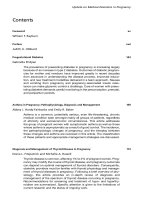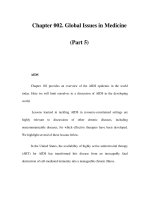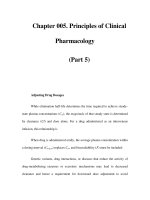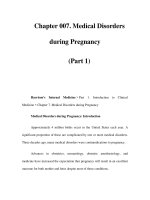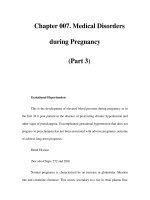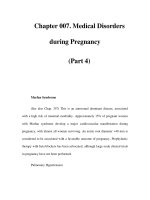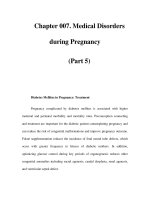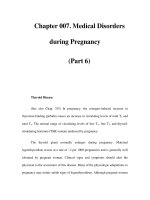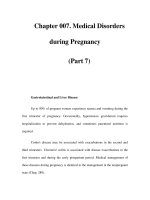Chapter 007. Medical Disorders during Pregnancy (Part 5) ppsx
Bạn đang xem bản rút gọn của tài liệu. Xem và tải ngay bản đầy đủ của tài liệu tại đây (11.72 KB, 4 trang )
Chapter 007. Medical Disorders
during Pregnancy
(Part 5)
Diabetes Mellitus in Pregnancy: Treatment
Pregnancy complicated by diabetes mellitus is associated with higher
maternal and perinatal morbidity and mortality rates. Preconception counseling
and treatment are important for the diabetic patient contemplating pregnancy and
can reduce the risk of congenital malformations and improve pregnancy outcome.
Folate supplementation reduces the incidence of fetal neural tube defects, which
occur with greater frequency in fetuses of diabetic mothers. In addition,
optimizing glucose control during key periods of organogenesis reduces other
congenital anomalies including sacral agenesis, caudal dysplasia, renal agenesis,
and ventricular septal defect.
Once pregnancy is established, glucose control should be managed more
aggressively than in the nonpregnant state. In addition to dietary changes, this
requires more frequent blood glucose monitoring and often involves additional
injections of insulin or conversion to an insulin pump. Fasting blood glucose
levels should be maintained at <5.8 mmol/L (<105 mg/dL) with no values >7.8
mmol/L (140 mg/dL). Commencing in the third trimester, regular surveillance of
maternal glucose control as well as assessment of fetal growth (obstetric
sonography) and fetoplacental oxygenation (fetal heart rate monitoring or
biophysical profile) optimizes pregnancy outcome. Pregnant diabetic patients
without vascular disease are at greater risk for delivering a macrosomic fetus, and
attention to fetal growth via clinical and ultrasound examinations is important.
Fetal macrosomia is associated with an increased risk of maternal and fetal birth
trauma. Pregnant women with diabetes have an increased risk of developing
preeclampsia, and those with vascular disease are at greater risk for developing
intrauterine growth restriction, which is associated with an increased risk of fetal
and neonatal death. Excellent pregnancy outcomes in patients with diabetic
nephropathy and proliferative retinopathy have been reported with aggressive
glucose control and intensive maternal and fetal surveillance.
Glycemic control may become more difficult to achieve as pregnancy
progresses due to an increase in insulin resistance. Because of delayed pulmonary
maturation of the fetuses of diabetic mothers, early delivery should be avoided
unless there is biochemical evidence of fetal lung maturity. In general, efforts to
control glucose and maintain the pregnancy until the estimated date of delivery
result in the best overall outcome for both mother and newborn.
Gestational Diabetes
All pregnant women should be screened for gestational diabetes unless they
are in a low-risk group. Women at low risk for gestational diabetes are those <25
years of age; those with a body mass index < 25 kg/m
2
, no maternal history of
macrosomia or gestational diabetes, and no diabetes in a first-degree relative; and
those not members of a high-risk ethnic group (African American, Hispanic,
Native American). A typical two-step strategy for establishing the diagnosis of
gestational diabetes involves administration of a 50-g oral glucose challenge with
a single serum glucose measurement at 60 min. If the plasma glucose is <7.8
mmol/L (<140 mg/dL), the test is considered normal. Serum glucose > 7.8
mmol/L (>140 mg/dL) warrants administration of a 100-g oral glucose challenge
with serum glucose measurements obtained in the fasting state, and at 1, 2, and 3
h. Normal values are plasma glucose concentrations <5.8 mmol/L (<105 mg/dL),
10.5 mmol/L (190 mg/dL), 9.1 mmol/L (165 mg/dL), and 8.0 mmol/L (145
mg/dL), respectively. Some centers have adopted more conservative criteria, using
<7.5 mmol/L (<135 mg/dL) as the screening threshold, and values of <5.3 mmol/L
(<95 mg/dL), <10 mmol/L (<180 mg/dL), <8.6 mmol/L (<155 mg/dL), and <7.8
mmol/L (<140 mg/dL) as the upper norms for a 3-h glucose tolerance test.
Pregnant women with gestational diabetes are at increased risk of
preeclampsia, delivering infants who are large for their gestational age, and birth
lacerations. Their fetuses are at risk of hypoglycemia and birth trauma (brachial
plexus) injury.
Gestational Diabetes: Treatment
Treatment of gestational diabetes with a two-step strategy of dietary
intervention followed by insulin injections if diet alone does not adequately
control blood sugar [fasting glucose < 5.6 mmol/L (<100 mg/dL) and 2-h post-
prandial <7.0 mmol/L (<126 mg/dL)] is associated with a decreased risk of birth
trauma for the fetus. More recently the use of the oral hypoglycemic agent
glyburide has become popular for managing gestational diabetes refractory to
nutritional management. More data on the safety and efficacy of glyburide for the
management of gestational diabetes are needed before it supplants insulin as the
treatment agent of choice. For women with gestational diabetes, within the 10
years after the index pregnancy there is a 40% risk of being diagnosed with
diabetes. All women with a history of gestational diabetes should be counseled
about prevention strategies and evaluated regularly for diabetes.
